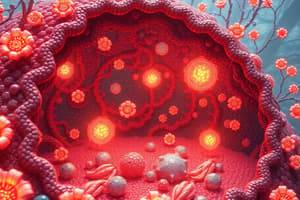Podcast
Questions and Answers
Which transport mechanism involves the movement of solute from an area of high concentration to an area of low concentration without energy input?
Which transport mechanism involves the movement of solute from an area of high concentration to an area of low concentration without energy input?
- Primary Active Transport
- Active Transport
- Facilitated Diffusion
- Simple Diffusion (correct)
What is the primary difference between primary and secondary active transport?
What is the primary difference between primary and secondary active transport?
- Primary active transport directly uses ATP, while secondary active transport uses ATP indirectly. (correct)
- Primary active transport moves substances with the gradient, while secondary active transport moves against it.
- Primary active transport requires specific carrier proteins, while secondary does not.
- Primary active transport is faster than secondary active transport.
Which mechanism describes the movement of water across a selectively permeable membrane?
Which mechanism describes the movement of water across a selectively permeable membrane?
- Osmosis (correct)
- Simple Diffusion
- Facilitated Diffusion
- Filtration
In a hypertonic solution, what occurs at the cellular level?
In a hypertonic solution, what occurs at the cellular level?
What type of transport mechanism would glucose utilize to enter a cell against its concentration gradient?
What type of transport mechanism would glucose utilize to enter a cell against its concentration gradient?
Which of the following accurately describes filtration in the context of cell membrane transport?
Which of the following accurately describes filtration in the context of cell membrane transport?
Which statement about tonicity is correct?
Which statement about tonicity is correct?
Which is true regarding facilitated diffusion?
Which is true regarding facilitated diffusion?
Flashcards
Filtration
Filtration
Movement of particles through a membrane driven by physical pressure, such as water and small solutes moving through capillary walls.
Simple Diffusion
Simple Diffusion
Movement of solute particles from an area of high concentration to an area of low concentration, without requiring membrane proteins.
Facilitated Diffusion
Facilitated Diffusion
Movement of specific molecules across a membrane, aided by transport proteins, following the concentration gradient.
Osmosis
Osmosis
Signup and view all the flashcards
Primary Active Transport
Primary Active Transport
Signup and view all the flashcards
Secondary Active Transport
Secondary Active Transport
Signup and view all the flashcards
Tonicity
Tonicity
Signup and view all the flashcards
Hypotonic
Hypotonic
Signup and view all the flashcards
Study Notes
Passive Transport
-
Filtration (passive): Particles driven through a membrane by physical pressure.
- Example: Water and small solutes moving through capillary walls due to blood pressure.
-
Simple Diffusion (passive): Movement of solute particles from high to low concentration.
- No membrane proteins needed.
-
Facilitated Diffusion (passive): Movement of solutes through a membrane protein.
- Substances include large, uncharged polar molecules (like glucose), and charged polar molecules (like amino acids and ATP).
- Movement is down the concentration gradient.
- Requires a carrier protein.
-
Osmosis (passive): Net flow of water through a selectively permeable membrane.
- Water moves from high to low concentration.
- Crucial for IV fluids, as solutes that can't pass through the membrane will draw water towards them.
- Colored substances dispersed in water to illustrate the process.
Active Transport
-
Primary Active Transport: Directly uses ATP; uses proteins often called pumps to move substances across the membrane.
-
Secondary Active Transport: Uses ATP indirectly by depending on a concentration gradient or other substances to move across the membrane. -One substance naturally diffuses, another substance "hitsches a ride" (symporter/antiporter). Protein are co-transporters
Tonicity
- Tonicity: Comparison of solute concentrations in two solutions.
- Hypotonic: Lower solute concentration than the cell (cell will swell)
- Isotonic: Equal solute concentration (normal cell shape)
- Hypertonic: Higher solute concentration than the cell (cell will shrink).
Studying That Suits You
Use AI to generate personalized quizzes and flashcards to suit your learning preferences.



